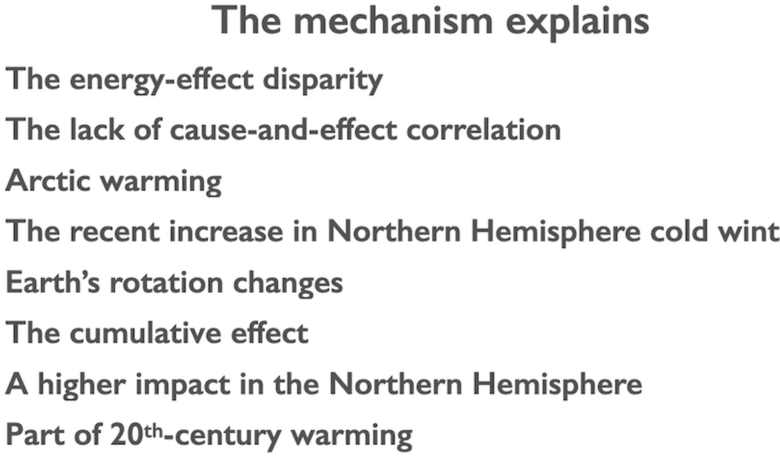How we know the sun changes the climate. III: Theories

By Javier Vinós
Part I in this series on the Sun and climate described how we know that the Sun has been responsible for some of the major climate changes that have occurred over the past 11,000 years. In Part II, we considered a range of changes that the Sun is causing in the climate today, including changes in the planet’s rotation and in the polar vortex that are changing the frequency of cold winters.
None of the evidence for the Sun’s effect on climate we reviewed is included in the IPCC reports. The role of the IPCC is to assess the risk of human-induced climate change, not to find the causes of climate change, which since its inception has been assumed to be due to our emissions.
- Main solar theories
Nevertheless, some scientists continue to try to explain the Sun’s effect on climate and have developed three different explanations. These three theories are not mutually exclusive. The fact that one is true does not mean that the others are false.
The first theory is based on the direct effect on climate of changes in solar radiation. Because the effect is proportional to the cause, we say it is linear.
This theory has been defended by Dr. Soon, Prof. Scafetta and 35 other scientists in a recent paper.[i] To explain the Sun’s effect on climate, these scientists make their own temperature reconstruction, based on rural stations to avoid the urban heat effect, and their own reconstruction of solar activity over the last two centuries. Figure 1 left shows their reconstruction compared to the one accepted by the IPCC on the right. The differences between the two would explain a much larger effect of the Sun on climate than that accepted by the IPCC.

Figure 1. Left graph shows in black a temperature reconstruction using only rural stations from four regions in NOAA’s GHCN dataset, and in orange a high variability solar series. Right graph shows in black a temperature reconstruction with urban and rural stations and in orange an IPCC’s AR6 recommended solar series (from Soon et al. 2023).
In the second theory, it is cosmic rays that change the climate, and the Sun’s magnetic field regulates the number of cosmic rays that reach the Earth. It is therefore an indirect effect, but also a linear one, since the change in cosmic rays would be proportional to the activity of the Sun.
This theory, proposed by Dr. Svensmark, is based on the fact that cosmic rays create ions in the atmosphere that act as cloud seeds.[ii] Part of the theory has been confirmed by experiments in a particle accelerator, but it is not yet known whether the effect is significant enough. One problem is that cosmic rays have increased while satellites show a decrease in the low cloud layer, which may actually contribute to the observed warming.

Figure 2. Percentage cloud cover anomaly (black) from EUMETSAT CM SAF dataset. Cosmic ray data (red) from the Oulu neutron monitor database.
The third theory is the one I have proposed.[iii] In it, the Sun acts indirectly on the climate, and its effect is non-linear because other factors are involved. Non-linear means that the effect is not proportional to the cause. This explains why there is no direct correlation between the Sun and surface temperatures, although the Sun’s effect is important. What is this process, capable of changing the climate in a natural way, that scientists have not properly accounted for? It is heat transport.

Figure 3. Three main types of solar theories based on the direct or indirect effect of different components of solar variability. Less developed hypotheses based on solar particles and solar wind have also been proposed.
- Changes in heat transport change the climate
What is heat transport?
Most of the Sun’s energy reaches the Earth in the tropics, creating a zone of excess energy that receives more energy than it emits, shown in red in Figure 4. Outside the tropics, there are two energy deficit zones, which receive less energy than they emit and whose size depends on the seasons. They are shown in blue in Figure 4, which presents the situation during winter in the Northern Hemisphere. These imbalances should result in continuous warming in the red zone and continuous cooling in the blue zones. That this does not happen is due to the transport of heat, which also transports moisture and clouds, and is very important for the climate. The climate of any region depends on insolation and the transport of heat and moisture.

Figure 4. Actual graphic of the mean top of the atmosphere net radiation by latitude for December-February, showing positive values in red and negative values in blue, placed in a cartoon showing the Earth’s tilt with respect to the Sun. The direction of heat and moisture transport is shown with purple arrows.
Heat transport is a particularly difficult climate process to study and some scientists who research it believe current theories do not satisfactorily describe it.[iv] The seasonal variation in heat transport is very important. Because of the tilt of the planet’s axis, much more heat is transported in the winter than in the summer.
In the first chapter of the 6th Assessment Report, the IPCC provides a clear explanation of climate change, defining its causes as follows: “The natural and anthropogenic factors responsible for climate change are known today as radiative ‘drivers’ or ‘forcers’. The net change in the energy budget at the top of the atmosphere, resulting from a change in one or more such drivers, is termed ‘radiative forcing’.” According to the IPCC, heat transport is not considered a radiative forcing and, therefore, not a cause of global climate change. Its effects only contribute to internal or regional variability. This perspective is reflected in the limited attention given to heat transport in the IPCC reports. In the massive 2,391-page 6th Assessment Report, heat transport is only briefly mentioned in a 5-page subsection on ocean heat content.[v] In this subsection, we learn that climate change is due to heat addition, while changes in ocean circulation cause heat redistribution.
To the IPCC, variations in heat transport have not contributed to recent climate change because they only redistribute heat within the climate system, while recent climate change is due to heat being added to the system. Therefore, heat transport cannot cause global climate change, only regional changes.

Figure 5. The first objection to changes in heat transport being a cause of climate change is incorrect because the greenhouse effect is very uneven, so emissivity is altered by poleward heat transport.
Is this true? Actually, it is not. It is rarely mentioned, but 75% of the Earth’s greenhouse effect is due to water vapor and water clouds.[vi] And their distribution by latitude is extremely uneven. The tropical atmosphere contains a lot of water, and the polar atmosphere in winter contains almost none. Therefore, the greenhouse effect in the polar regions is extremely small, and the transport of heat from the tropics to the Arctic changes the emissions. This means that the total is not constant, so heat transport has the ability to change the global climate through changes in water vapor and cloud distributions.
In the 1960s, Jacob Bjerknes stated that if the top of the atmosphere fluxes and oceanic heat storage remained relatively stable, the total heat transported through the climate system would also remain constant. This implies that changes in atmospheric or oceanic transport should be compensated by changes of the same magnitude and opposite sign in the other one. This Bjerknes compensation has not been empirically demonstrated but is present in all models despite its physical basis being unknown.[vii] If the compensation is true it should result in transport being constant and, thus, not a cause for climate change.

Figure 6. The second objection to changes in heat transport being a cause of climate change is incorrect because heat transport to the Arctic does not show the expected compensation.
But again, reality is different. Heat transport can increase in the atmosphere and also in the ocean, changing the amount of energy transported. In fact, this is logical because an important part of ocean transport is in surface currents driven by wind, which is also responsible for heat transport through the atmosphere. If the wind increases, the transport in both compartments should increase.

Figure 7. Upper graph, tropospheric winter latent energy transport across 70°N by planetary scale waves (Rydsaa et al., 2021). Lower graph ocean heat transport to the Arctic and Nordic Seas in Terawatts (Tsubouchi et al. 2021).
This is also supported by data from two studies of Arctic heat transport in recent decades.[viii] Both atmospheric and oceanic heat transport increased in the early 21st century. In the Arctic, winter temperatures have risen sharply. Obviously, that heat has to be transported there, because the Sun does not shine in the Arctic in winter, so no heat is generated. And the increase in temperature has greatly increased the emission of infrared radiation into space. Remember that the greenhouse effect is very weak in the Arctic at this time of year, and heat is not retained. Because of the warming of the Arctic caused by increased transport, the planet is losing more energy than it was losing before.

Figure 8. Upper graph, Arctic winter temperature anomaly. Data from Danish Meteorological Institute. Lower graph, 5-year November-April average outgoing longwave radiation anomaly at 70-90°N top of the atmosphere from NOAA data (black) and solar activity (sunspots, red) with a decadal Gaussian smoothing (thick line).
So, what has caused this warming of the Arctic in the 21st century? CO₂ has been rising sharply since the 1950s and its effects on radiation are instantaneous, they do not take 50 years. There’s also talk of it being a consequence of the warming that’s been going on since the mid-1970s, but why should it take two decades for the heat to reach the Arctic? We have the Sun. Arctic warming and increased outgoing radiation coincide in time with the decline in solar activity that began in the mid-1990s with solar cycle 23, which, as we have seen, was accompanied by a weakening of the polar vortex.
How do we know that the change in solar activity caused the change in transport and the warming of the Arctic? Because it has been doing so for thousands of years. A study by leading scientists looked at the relationship between solar activity and Greenland’s temperature and found that over the past 4,000 years, solar activity has been inversely correlated with Greenland’s temperature.[ix] When solar activity decreased, Greenland warmed, as it is doing now. It also says that there have been periods in those 4,000 years when Greenland was warmer than it is now, which is inconsistent with being caused by our emissions.
- How the Sun changes heat transport
The signal from the Sun is received in the stratospheric ozone layer, which absorbs much of the ultraviolet radiation. This is a very sensitive receiver because UV radiation changes 30 times more than total radiation (3%). But in addition, the increase in UV radiation creates more ozone, which also increases by 3%. With more ozone and more UV radiation, the ozone layer experiences a temperature increase of 1°C with solar activity, which is much more than at the surface.
The ozone response to changes in solar activity modifies the temperature and pressure gradients, and this causes the speed of the zonal winds in the stratosphere to change, as we saw earlier. When the activity is high, the gradients become larger and this causes the wind speed to increase, and when the activity is low, the gradients become smaller and the wind speed decreases. In the troposphere, atmospheric waves called planetary waves are generated, and when the wind is weak, they reach the stratosphere and hit the polar vortex, weakening it. But when the wind is strong, they do not manage to enter the stratosphere and the vortex remains strong. Changes in the vortex are transmitted to the troposphere, altering atmospheric circulation and heat transport.

Figure 9. Cartoon showing the mechanism by which solar activity regulates planetary wave activity in the stratosphere and the polar vortex strength and, through it, winter atmospheric circulation and heat transport toward the Arctic.
Planetary waves are atmospheric waves of the Rossby type. The largest storms on the planet fit into their undulations and have a huge impact on meteorology. They are responsible for some of the most extreme atmospheric phenomena, such as the heat waves in Europe in 2003 and in Russia in 2010, and the floods in Pakistan in 2010, in China in 2012, and in Europe in 2013. The amount of energy they move is staggering. Planetary waves are the largest of all, and under certain conditions can reach the stratosphere, hitting the polar vortex and weakening it.
Fifty years ago, a scientist suggested that if the Sun had an effect on climate, planetary waves were a possible candidate for the mechanism.[x] But no one investigated this possibility, and the paper was forgotten.
A 2011 study finally proved him right, showing that planetary waves in the Northern Hemisphere respond to the solar cycle.[xi] Figure 10 shows the sunspot cycle in red and the amplitude of the planetary waves in black. We observe large oscillations from one year to another because the mechanism is not exclusive to the Sun and there are other causes that affect it. This is the difficulty of studying non-linear phenomena. But the effect of the solar cycle is clear, because the highest amplitudes occur in periods of low solar activity.

Figure 10. Planetary wave amplitude index based on the averaged amplitude of wavenumbers 1–3 averaged over 55–75°N in 70–20 hPa (black, from Powell & Xu, 2011). Annual sunspot index (red, from SILSO). Purple circles indicate high wave amplitude years that coincide with low solar activity.
The effect this has on the polar vortex was discussed in Part II and is shown in Figure 11. More active solar cycles, with fewer planetary waves, have faster zonal winds and stronger vortices, while during less active solar cycles the increase in planetary waves weakens the vortex.

Figure 11. Monthly sunspot number (red), cumulative anomaly of zonal wind speed at 54.4°N, 10 hPa (blue, Lu et al. 2008), and the mean vortex geopotential height anomaly at 20 hPa (purple, NCEP, Christiansen 2010).
We have already mentioned the effect this has on the frequency of cold winters in the Northern Hemisphere, but how does this mechanism explain the change in global climate?
- How the Sun changes the climate
My theory is that when solar activity is high, the zonal winds are strengthened, preventing the planetary waves from entering the stratosphere and allowing the vortex to remain strong throughout the winter. By acting as a wall, the vortex reduces heat transport to the Arctic in winter, and this causes temperatures to drop, reducing the infrared emissions to space that allow heat to escape from the Earth. All of these steps have been verified by scientists. The result is that by reducing emissions, the planet conserves more energy, which can cause it to get warmer. This is the situation that occurred from the mid-1970s to the late 1990s, when the planet experienced strong warming under high solar activity.

Figure 12. Climate-changing mechanism through changes in heat transport as a result of high solar activity.
When solar activity is low, the zonal winds subside, allowing planetary waves to enter the stratosphere and hit the vortex, weakening it. As the wall weakens, heat transport to the Arctic increases, causing it to warm. This warming increases emissions to space, causing the planet to conserve less energy. The result is that the planet either warms more slowly or cools, depending on other factors. Because this mechanism regulates the amount of heat that enters the Arctic in winter, I have named my theory “The Winter Gatekeeper”.

Figure 13. Climate-changing mechanism through changes in heat transport as a result of low solar activity.
It is important to note that this is not a solar theory, although it does explain the Sun’s effect on climate. Variations in heat transport are a general cause of climate change. Perhaps the most important one. Any factor that persistently changes the amount of heat transported becomes a cause of climate change, and this includes plate tectonics and orbital variations. This theory has the ability to explain the ice age of the last 34 million years, and the growth and shrinkage of the ice sheets in glaciations and interglacials.[xii] The explanations it provides fit the evidence better than the CO₂ changes.
The solar mechanism I propose has the following features:
- It is indirect, because what changes the climate is not the change in solar energy, but the change in heat transport.
- It is exclusively due to changes in the Sun’s ultraviolet radiation.
- It produces dynamic changes in the stratosphere, which is the part of the climate system whose response to the Sun is important for climate change.
- The mechanism works by altering the propagation of planetary waves, as proposed 50 years ago.
- Since there are multiple causes that affect this propagation, the cause-effect relationship becomes non-linear, which makes it very difficult to study because we humans think linearly.
- It affects the polar vortex, which is responsible for transmitting what happens in the stratosphere to the troposphere, determining the position of the jet streams and the atmospheric circulation in winter.
- In its final part, the mechanism alters the transport of heat to the Arctic in winter. This is the most visible effect of the Sun on climate. Winter temperatures in the Arctic and the frequency of cold winters in eastern North America and Eurasia reveal the Sun’s effect on climate.
- Finally, the mechanism works because the greenhouse effect is extremely heterogeneous across the planet. It is a very thick blanket in the tropics, leaving the poles exposed. Increasing CO₂ doesn’t change that because most of the greenhouse effect is due to water, which changes much more than CO₂.
This theory explains many of the problems that the Sun’s effect on climate has always had:

Figure 14. The solar part of the Winter Gatekeeper theory provides an explanation for several questions and solar-climate related phenomena, some of them not properly explained before.
- It explains the mismatch between the small change in solar energy and the resulting climate effect. The change in solar energy only provides the signal, like the finger pushing the button on an elevator. The energy to change the climate is provided by planetary waves, which carry very large amounts of energy and act on sensitive parts of the climate.
- It explains the lack of cause-and-effect correlation claimed by NASA and the IPCC. It is a non-linear process that cannot be required to have a linear correlation.
- It explains the recent warming of the Arctic, the timing of which cannot be explained by CO₂ or global warming.
- It explains the recent increase in cold winters in the Northern Hemisphere that scientists cannot adequately explain.
- It explains changes in the Earth’s rotation due to the Sun that no one has been able to explain. Changes in atmospheric circulation induced by the Sun are what alter the angular momentum responsible for variations in the Earth’s rotation.
- It explains the cumulative effect of changes in solar activity on climate. Why grand solar minimums have such a large effect, proportional to their duration. Low activity alters the energy balance by increasing emissions throughout the duration of the grand minimum, progressively reducing the energy of the climate system and causing the effects to become larger and global over time.
- It explains the greater impact of solar-induced climate change on the Northern Hemisphere, as it affects the heat transported to the Arctic. The Antarctic polar vortex is much stronger and less sensitive to solar forcing. This is why the Medieval Warm Period and the Little Ice Age, caused by solar forcing, were much more pronounced in the Northern Hemisphere.
- It also explains a significant part of the 20th century warming. The 70 years of grand solar maximum in that century caused the planet to increase its energy and warm up.
- Conclusion
The Sun has a lot to say about future climate, but we are not listening. Long-term changes in solar activity are cyclical, and what adds to warming now will subtract from it in the future. This theory does not deny that changes in CO₂ affect climate, and indeed it is based on differences in emissions due to changes in the greenhouse effect, just not in time, but in space, with latitude. But it is undeniable that if the Sun has played a relevant role in the warming of the 20th century, it reduces the role our emissions have played.
This article can also be watched in a 19-minute video with English and French subtitles.
References
[i] Soon, W., et al., 2023. The detection and attribution of northern hemisphere land surface warming (1850–2018) in terms of human and natural factors: Challenges of inadequate data. Climate, 11 (9), p.179.
[ii] Svensmark, H., 1998. Influence of cosmic rays on Earth’s climate. Physical Review Letters, 81 (22), p.5027.
[iii] Vinós, J., 2022. Climate of the Past, Present and Future. A scientific debate. Critical Science Press. Madrid.
[iv] Barry, L., et al., 2002. Poleward heat transport by the atmospheric heat engine. Nature, 415 (6873), pp.774-777.
[v] Fox-Kemper, B., et al., 2021. Climate Change 2021: The Physical Science Basis. 6th AR IPCC. Ch. 9 Ocean, Cryosphere and Sea Level Change. pp.1228–1233.
[vi] Schmidt, G.A., et al., 2010. Attribution of the present‐day total greenhouse effect. Journal of Geophysical Research: Atmospheres, 115 (D20).
[vii] Outten, S., et al., 2018. Bjerknes compensation in the CMIP5 climate models. Journal of Climate, 31 (21), pp.8745-8760.
[viii] Rydsaa, J.H., et al., 2021. Changes in atmospheric latent energy transport into the Arctic: Planetary versus synoptic scales. Quarterly Journal of the Royal Meteorological Society, 147 (737), pp.2281-2292. Tsubouchi, T., et al., 2021. Increased ocean heat transport into the Nordic Seas and Arctic Ocean over the period 1993–2016. Nature Climate Change, 11 (1), pp.21-26.
[ix] Kobashi, T., et al., 2015. Modern solar maximum forced late twentieth century Greenland cooling. Geophysical Research Letters, 42 (14), pp.5992-5999.
[x] Hines, C.O., 1974. A possible mechanism for the production of sun-weather correlations. Journal of the Atmospheric Sciences, 31 (2), pp.589-591.
[xi] Powell Jr, A.M. and Xu, J., 2011. Possible solar forcing of interannual and decadal stratospheric planetary wave variability in the Northern Hemisphere: An observational study. Journal of Atmospheric and Solar-Terrestrial Physics, 73 (7-8), pp.825-838.
[xii] Vinós, J. 2023. Solving the Climate Puzzle. The Sun’s surprising role. Critical Science Press. Madrid.




